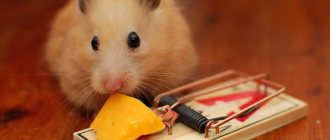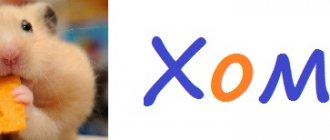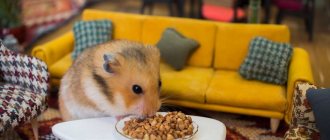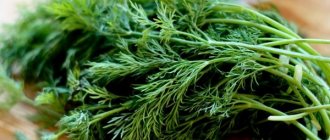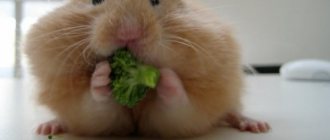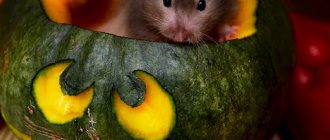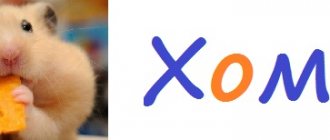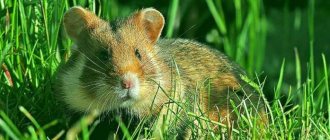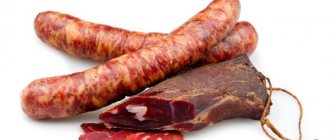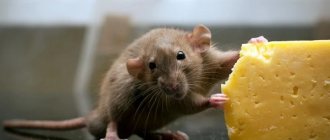- home
- Nutrition
19.03.2018
Strawberries have beneficial properties and essential vitamins. They are grown in all European countries and in Russia. Pet owners often want to give their pets a taste of this sweet product. But can hamsters have strawberries? The fruit contains the following components:
- Folic acid.
- Iodine.
- Microelements of iron.
- Magnesium.
- Calcium.
- Contains vitamin substances.
We need to figure out whether hamsters can eat strawberries. These berries prevent the development of diseases characteristic of this type of animal:
- Formation of cancer cells.
- Diseases of the genitourinary organ systems.
- Diseases of arthritis of various joints.
At the same time, strawberry fruits have anti-inflammatory and antimicrobial properties, which helps strengthen the immune system and serves as the prevention of infectious diseases in the animal. Fruits and berries add variety to a hamster's diet.
Strawberry composition
This berry is rich in vitamin C and folic acid. It also contains magnesium, sodium, calcium, iron and even iodine. Strawberries consist of 80-90% water. All other contents are dry matter.
Strawberries are fruits with a small amount of sugar: fructose and glucose are about 2.5%, and sucrose is about 1%.
This small berry has a positive effect on the cardiovascular system, participating in hematopoiesis, and also perfectly strengthens the immune system. It is an anti-inflammatory and antitumor agent.
Prohibited foods can be deadly
The list of what is prohibited is very extensive; in fact, there are much more prohibited products than can be covered in one article. But the list of what can be given to Djungarian hamsters from food is also impressive, so there is no point in experimenting with unsafe products. The ban may seem unreasonable, but there is always a reason.
Risk of poisoning
Some food that is familiar to us is real poison for the Djungarians . Almonds and apricot kernels contain hydrocyanic acid, watermelon accumulates nitrates, honeysuckle and elderberry cause suffocation and cramps. Potatoes may contain solanine. The problem is the small size of the animal and its sensitive body. Even a microscopic dose of a dangerous substance can cause intoxication.
Cause constipation
Any astringent products (persimmon) slow down intestinal motility due to the high content of tannins. Constipation is very dangerous for rodents.
Causes diarrhea
Foods that irritate the digestive tract or have a laxative effect should not be given to dwarfs. This is hot ginger and any spices that are found in human food (paprika, salt).
Cause fermentation
Intestinal bloating leads to the death of the rodent in a matter of hours. Foods that cause gas include cabbage, brown bread, and beans.
Too fat
The rodent's liver is not able to cope with foods that are too fatty. Even seeds, which are what Djungarians can eat, are given in moderation, and foods such as oil and fried foods are completely excluded. Avocado contains too much fat.
Cheek pouches hurt
Sometimes the product itself is not dangerous. But given the small size and habits of the pet, it causes problems. Dry pasta should not be given to your dwarf hamster, not because wheat is dangerous, but because it can injure its cheek pouches by stuffing spaghetti there.
Abscesses and inflammation of the sac are a serious problem that requires treatment. Owners, faced with such a nuisance, even first peel the seeds from the husks before feeding the jungarians.
Allergy risk
Essential oils, brightly colored fruits, vegetables and berries can cause allergies. If after eating strawberries your hamster’s eyes run, the skin turns red and itches, it should be excluded.
Sometimes a product is prohibited for several reasons: cheese is both salty, fatty and rich in lactose, which is very difficult to digest.
What kind of strawberries can pets eat?
Due to the high content of vitamin C, but at the same time a small amount of sugar, the presence of various macro- and microelements, as well as liquid, strawberries are not only possible, but also should be given to the hamster. But as with most products, certain conditions must be observed with this berry.
You should avoid eating early varieties of strawberries, which are often treated with nitrogen fertilizers, pesticides and growth stimulants. The berry should be fresh and juicy, but without rot or visible damage that could harbor fungus. Strawberries should be purchased exclusively during their ripening season and preference should be given to local varieties. It is best to buy berries at the market, paying attention to the sellers. Give preference to strawberries that are grown in the place where you live; such berries are less likely to be sprayed for longer storage.
You should include strawberries in your diet every few days. One small berry is enough. If the strawberry is large, give your pet half a berry.
Dried fruits for hamsters
In winter, instead of not very healthy fresh fruits from the store, it is better to occasionally give your hamster dried fruits, but also in dosed doses. Such treats are often offered as treats and rewards during training. Ideally, of course, prepare them yourself using a special dryer or oven. The raw materials should not be too sweet - apples, pears, viburnum, cranberries, lingonberries.
Article on the topic: Can hamsters eat apples: Djungarian, Syrian, Campbell and other breeds
It is worth considering the characteristics of the pet and its predisposition to diabetes. So, in the diet of the Campbell breed they often do without dried fruits; the Djungarian hamster is given less sweet treats, for example, apple slices. Syrian hamster and other species can be given raisins, homemade banana chips and a small piece of prunes 1-2 times a week.
Results
Can hamsters eat strawberries? Yes. Especially if it is from your garden or purchased from a trusted seller. Half a large berry in one to two days in the evening diet is enough for a hamster to get the benefit and avoid negative consequences in the form of an upset stomach.
Did you like the article? Share with friends: [supsystic-social-sharing id=”1"]
- Related Posts
- What cereals can hamsters eat?
- What do Djungarian hamsters eat?
- Can hamsters have fresh parsley and dill?
« Previous entry
Fruits for your hamster
Hamsters can be given various fruits (with the exception of citrus and exotic ones), but in small doses. The high sugar content makes this complementary food unsafe. Domestic Djungarians are given less of it than individuals of the Syrian breed - within 5% of the main diet. Campbell's hamsters are fed even more carefully.
The main fruit products that are suitable for Syrian and Djungarian hamsters include:
- apple - choose sweet and sour varieties, introduce them from 4 months, do not give to lactating females;
- apricot – a little and not overripe, it is better to give dried apricots out of season;
- peach is better than nectarine, it has less sugar;
- pear – firm yellow or green, uncommon;
- banana – preferably a little greenish, just unripe;
- plum - a little at a time, so as not to provoke diarrhea;
- melon – due to excessive sweetness, allowed only once every 5-7 days;
- watermelon - also rare, but from your own garden (it’s hard to find a store-bought one without nitrates).
Berries will help diversify your diet. Strawberries are offered once every 7 days, a piece with a diameter of 1 cm. The rest of the berries from the list are given 1 piece per week, the portion for the Syrian hamster is doubled. Allowed:
- cherries and sweet cherries (pits removed);
- currant;
- not sour gooseberries;
- grape;
- raspberries;
- blueberry;
- blackberry;
- cowberry;
- blueberry.
Of all of the above, only dietary fruits are suitable for Campbell's hamsters. These are nectarine, blueberry, lingonberry, cherry, hawthorn. It is worth remembering that exotic fruits (mango, avocado, kiwi, pineapple and others) are prohibited from being offered to all rodents. They can cause severe allergic reactions and digestive problems.
Features of feeding a pregnant or lactating female
When feeding and bearing offspring, the female will eat more than at other times. This is due to an increase in the daily intake of nutrients. It is important to provide high-quality food to pregnant and lactating females. It should contain vitamins and minerals. It must be supplemented with herbs, cereals, protein supplements, fruits and vegetables from the list of permitted ones. The diet is planned so that products from different categories are present.
It is better to keep the mineral stone in the Syrian hamster's cage at all times.
Veterinarians recommend giving pregnant females extra treats. Pieces of chalk or mineral stones will do. When bearing offspring, it is important to provide the hamster with maximum comfort. The animal may become nervous if food portions are small and there is no supply, so it is better to offer the pet a little extra food. The female will determine how much she needs to eat.
What to feed the babies
Up to 1 month, the cubs feed only on mother's milk. If necessary, it is allowed to supplement or completely feed them with soy-based infant formula for newborns. Substitutes for kittens are also suitable.
At 1 month, the hamster’s digestive system has not yet fully formed, but is ready for a gradual transition to a standard diet. The cubs are given grain food, giving them the opportunity to choose what they like best. Milk porridge and steamed buckwheat or oat flakes with the addition of baby purees are suitable for feeding small hamsters.
Other products are introduced gradually and 1 at a time. Start with fresh herbs, young shoots and sprouted grains. Nuts, fruits and other treats that are difficult for the gastrointestinal tract are introduced later, after growing up.
Vintage basket
Here we are dealing with a representative design in the style of modern rural fashion. Best suited for lovers of cycling or short distance travel on scooters. The basket itself is woven from flexible willow and equipped with an openwork wire lid, which prevents the cat from wanting to get out while moving. At the first glance at such a carrier, one is reminded of idyllic pictures from centuries ago, when food from the market was transported in a similar way on bicycles. The entire structure is conveniently attached to the steering wheel using leather straps and does not require much time for preparation.
The advantage of the option under consideration is, of course, its original design and originality. The downside is limited functionality. Although, if desired, the basket can be used for its intended purpose.
Price – 1,128 – 1,708 rubles.
Drinking fountain
Such a device can serve not only to quench the thirst of animals, but also become an original accent in the home interior.
The design consists of a water bowl, a filter, a diffuser and a drinking bowl located at the top. Additionally, it is equipped with a decorative sprinkler, especially popular with native breeds (Maine Coons, Kuril Bobtails, Siberian cats). Continuous circulation of liquid is ensured by a mini-pump powered by a USB cable. More advanced models may contain backlighting and an indication of the level of remaining water in the tank.
Cost – 2400 rub.
Excessive attention from owners
Close attention and excessive care will harm not only human relationships, but can also become a reason for cannibalism in female hamsters. Since this rodent is a solitary animal, and after the birth of the cubs, the female needs a secluded environment and tranquility even more, excessive care will only harm these animals
Do not pick up hamsters and do not get into the cage. Let your family see you less.
Foreign odors repel the mother hamster. Sensing a foreign smell, she does not identify the cubs as her own creatures and, as a result, abandons them and destroys them. Do not touch the hamster family for one to two weeks after the babies are born!
It is necessary to prepare in advance for the new offspring of furry rodents. When cleaning the cage, if you find hamster supplies, do not touch them. This is a strategic supply of products, which unpleasantly traumatizes the animal’s psyche in the event of its loss, even to the point of an uneven breakdown in a pregnant female. Only spoiled products can be thrown away to avoid the growth of putrefactive bacteria, odor and poisoning.
To arrange your own nest, it is recommended to put a few paper napkins. Your task is to fill the drinking bowl with clean drinking water and pour food into the feeder on time. This is all that the rodent needs from its owner at this time. Nature will do the rest.
